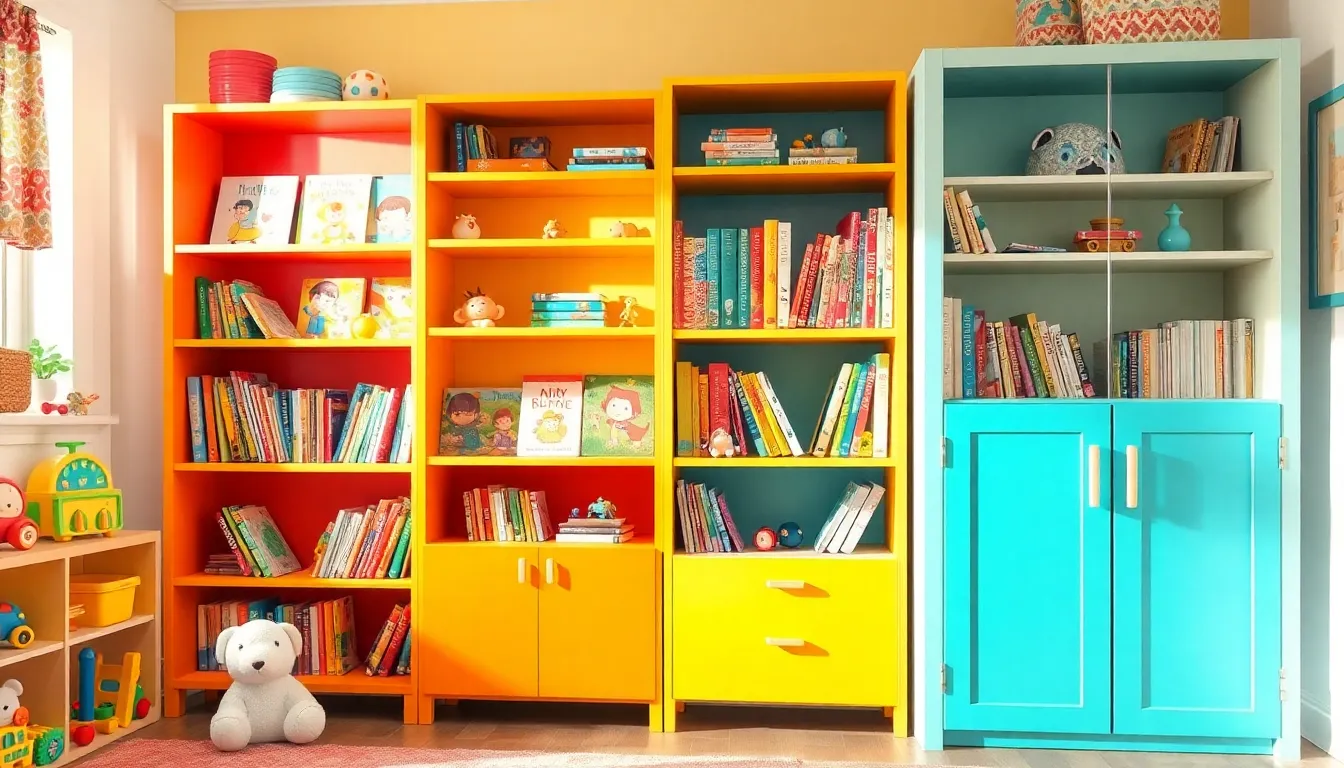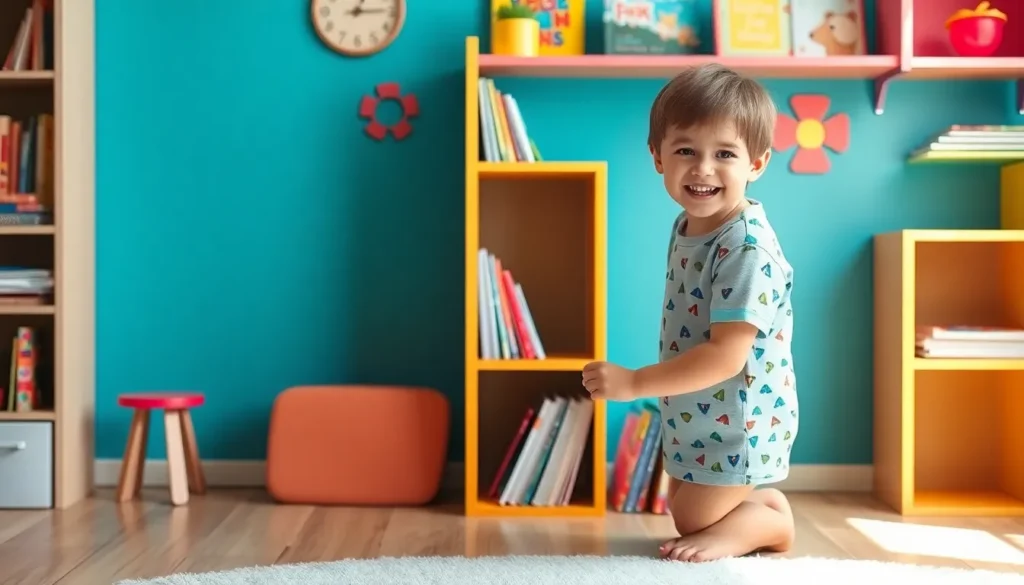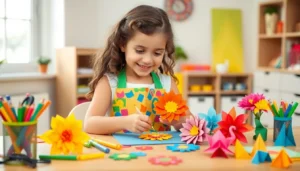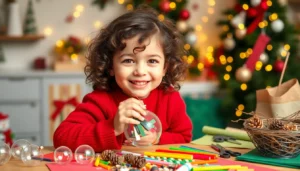Every parent knows that kids’ books can quickly take over a room, transforming it into a chaotic literary jungle. But what if there was a way to tame that wild mess while adding a splash of creativity to your home? Enter the DIY kids bookshelf—your new best friend in the battle against clutter and the champion of organization.
Overview of DIY Kids Bookshelves
DIY kids bookshelves serve as practical solutions for managing children’s book collections. Crafting a customized bookshelf enhances organization and adds character to the living space. Many families face challenges with children’s books scattered everywhere. Building a unique bookshelf fosters creativity and instills a sense of ownership in kids.
Flexibility stands out as a key benefit of DIY projects. Parents can choose sizes, colors, and styles that align with existing decor. Various materials, such as wood, crates, and PVC pipes, allow for endless design possibilities. For instance, wooden bookshelves can feature personalized designs, while crate-based shelves bring a rustic touch.
Cost-effectiveness represents another important aspect. Creating a DIY bookshelf often involves lower expenses than purchasing pre-made options. Savings can be substantial, especially considering the need for quality materials. Additionally, many projects require only basic tools such as a saw, screws, and a drill, making it accessible to most individuals.
Safety remains a top priority in any children’s project. DIY bookshelves can incorporate rounded edges and non-toxic finishes, ensuring a secure environment for little ones. Considering structural stability when building shelves prevents accidents and ensures long-lasting use.
Lastly, the educational benefits of a personalized bookshelf cannot be overlooked. Engaging children in the building process helps develop their skills and understanding of organization. This activity encourages them to appreciate their books and enhances a love of reading.
Types of DIY Kids Bookshelves

Various styles of DIY kids bookshelves cater to different needs and preferences. Each type offers unique benefits, making it easier to find the perfect fit for a child’s room.
Open Shelving Designs
Open shelving designs provide easy access to books, encouraging children to select titles independently. These shelves often come with a minimalist aesthetic, which creates a spacious feel in smaller rooms. Visual appeal enhances when the shelves showcase colorful book covers. Adjustable height options allow for customization as children grow, ensuring longevity. Additionally, incorporating vibrant colors or playful shapes into designs can make the shelves an attractive part of the decor.
Enclosed Bookshelves
Enclosed bookshelves offer a more organized approach by protecting books from dust and damage. Secure doors keep shelves tidy and books safely stored. Designs often include glass or wooden doors, blending style with function. Various sizes are available, ranging from small units perfect for toddlers to larger options suitable for avid young readers. Adding compartments or drawers can further enhance storage capabilities, making it easier to keep reading materials organized.
Materials Needed for DIY Kids Bookshelf
Creating a DIY kids bookshelf requires the right materials for durability and safety. Various wood options and alternative materials offer choices that accommodate different styles and budgets.
Wood Options
Pine, a common choice, is lightweight and easy to work with. Birch plywood adds strength and a smooth finish, making it suitable for painted or stained projects. Oak offers durability and a beautiful grain, ideal for long-lasting bookshelves. For a budget-friendly option, select MDF, which provides a smooth surface and can be painted in vibrant colors. Each wood type serves a unique purpose, allowing customization for different preferences and designs.
Alternative Materials
Recycled pallets present an eco-friendly option, providing rustic charm while saving costs. Cardboard can also serve temporary storage but isn’t as sturdy or long-lasting as wood. Consider using fabric for soft, flexible shelving, creating fun designs that fit a child’s room. Metal brackets or pipes may also be integrated into unique designs, offering an industrial look. Each alternative facilitates creativity while meeting practical needs for a kids bookshelf.
Step-by-Step Guide to Building a DIY Kids Bookshelf
This guide provides clear instructions for creating a functional and attractive kids bookshelf. Follow these steps to ensure a successful project.
Designing Your Bookshelf
Begin by measuring the space where the bookshelf will go. Consider the height and width suitable for children’s access and available room. Choose a design style that complements the existing decor, whether it’s colorful open shelving or enclosed compartments. Sketch a layout including shelves, dimensions, and any additional features. Define the color palette to match the child’s room, selecting non-toxic paints for safety. Maintain an engaging look, perhaps incorporating fun shapes or themed elements.
Assembly Instructions
Gather all the materials and tools needed before starting. Assemble the frame first, connecting the wooden pieces using screws. Ensure each joint is secure, checking for stability as you go. Attach the shelves according to your design, placing them at adjustable heights if desired for versatility. Sand the edges to prevent splinters, especially on corners. Paint or stain the bookshelf to match your design concept. Allow time for finishes to dry completely before moving on. Secure the shelf to the wall if needed for safety, particularly in rooms with energetic children.
Decorating and Personalizing Your Bookshelf
Enhancing a DIY kids bookshelf can transform it into a unique focal point in any room. Various elements contribute to making it truly special.
Paint and Finish Options
Choosing the right paint or finish can influence the appearance and durability of the bookshelf. Non-toxic paints in vibrant colors encourage creativity and match existing decor. Satin finishes offer a soft sheen, while matte provides a contemporary touch. Consider using a water-based sealant to protect the surface and increase durability. Natural wood stains can highlight grain patterns, adding warmth and character. Complementing the room theme can tie the bookshelf seamlessly into the overall aesthetic.
Adding Fun Elements
Incorporating fun elements makes a bookshelf more appealing to kids. This can include whimsical decals, colorful bookends, or themed shelving designs. Attach hooks for hanging backpacks or art supplies at the sides. Use fabric bins or baskets for additional storage that comes in playful patterns. Integrate LED lights to illuminate the space and create a cozy reading nook. Personal touches, like family photos or child-made art, enhance the bookshelf’s charm and encourage an ownership feeling. Each of these additions fosters a lively environment, making reading inviting and enjoyable.
Tips for Ensuring Safety and Durability
Ensuring safety and durability in a DIY kids bookshelf requires thoughtful planning. Start with selecting solid wood materials like birch plywood or oak, as these options provide strength and stability. Consider using lightweight pine if the design includes floating shelves; it offers ease of installation without sacrificing sturdiness.
Securing the bookshelf to the wall enhances safety, preventing tipping during use. Use brackets or mounting hardware designed for furniture attachment. Check weight limits for shelves; this ensures they can hold books without bending or breaking.
Rounded edges on shelves minimize injury risks, especially for energetic toddlers. Also, sand all surfaces thoroughly, eliminating sharp corners and splinters that could harm little hands. Non-toxic finishes and paints are essential; choose products verified to be safe for children’s furniture.
Incorporating a low center of gravity in the design adds stability. This can be achieved by building wider bases or lower shelves; it keeps the bookshelf grounded. Instead of thin shelves, opt for thicker ones, as these maintain shape under the weight of books.
Regular maintenance helps preserve the bookshelf’s durability. Periodically check for loose screws or wear in joints, tightening or repairing as necessary. Reinforcing joints with wood glue or brackets can enhance structural integrity over time.
Adding a protective layer, such as a clear coat, can guard against spills and stains. This not only preserves the aesthetic but also increases longevity. Ultimately, a well-built, safe bookshelf complements any child’s space while encouraging a love for reading.
Creating a DIY kids bookshelf offers a rewarding experience that not only declutters spaces but also nurtures a child’s love for reading. By customizing the design to fit personal styles and needs families can create a functional yet aesthetically pleasing addition to their home.
Involving children in the building process enhances their creativity and ownership while promoting essential skills. With safety and durability as top priorities families can ensure their DIY project stands the test of time.
Whether opting for open shelving or enclosed designs the possibilities are endless. A well-crafted bookshelf can become a cherished centerpiece that inspires countless adventures through the pages of books.





